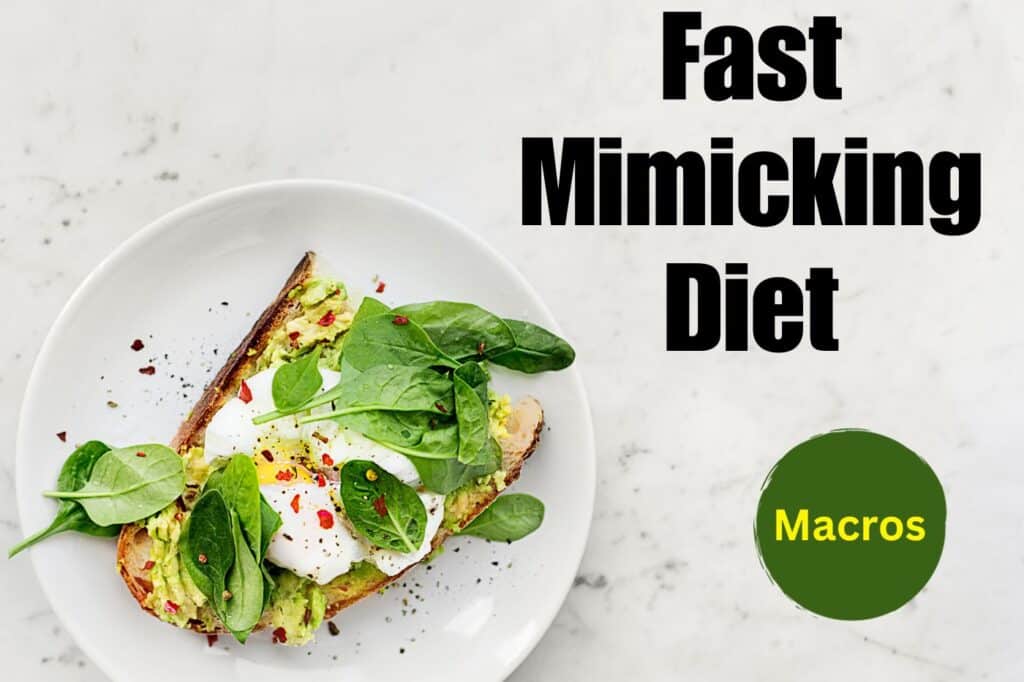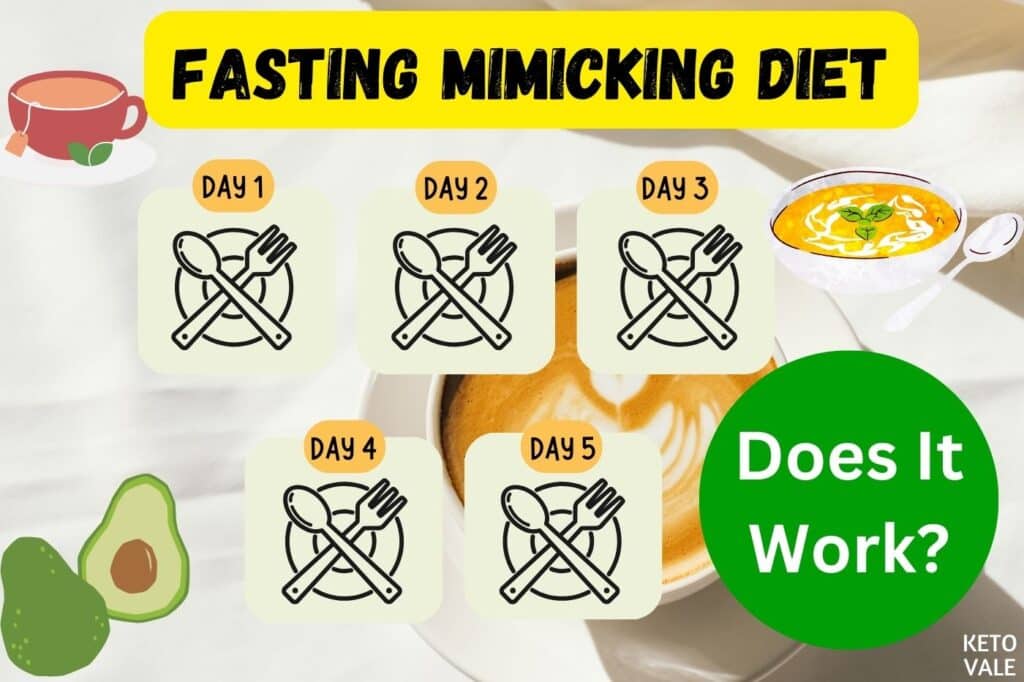Key Takeaways:
- The Fasting Mimicking Diet is a five-day protocol designed to replicate the physiological effects of fasting while providing pre-packaged meals.
- Potential health benefits include weight loss, improved metabolic and cardiovascular health, enhanced cognitive function and longevity.
- Consult with a healthcare provider before beginning the FMD journey for optimal outcomes.
In the world of fasting diets and calorie restriction, the Fast Mimicking Diet (FMD) has emerged as a novel approach to intermittent fasting to help with weight loss, blood pressure, autophagy and more (we’ll explain in details below).
Unlike traditional fasting methods, the fast mimicking diet offers the potential health benefits of fasting while still permitting a limited intake of low-calorie, nutrient-dense foods.
Intriguing, isn’t it? How could this be? Let’s delve into this innovative dietary approach.
Who Invented The Fasting Mimicking Diet (FMD)?
The Fasting Mimicking Diet (FMD) is a revolutionary eating plan innovated by Dr. Valter Longo, a professor at the University of Southern California and the Director of the USC Longevity Institute as well as the author of The Longevity Diet.
This five-day program, scientifically developed and clinically tested, is designed to mimic the effects of water-only fasting. While providing the body with healthy, natural ingredients, FMD tricks the body into a fasting state, offering the benefits of traditional fasting such as cellular rejuvenation, without complete food deprivation.
FMD’s effectiveness lies in its unique approach of inducing a fasting-like mode in the body while still allowing nutrient intake. Created under the guidance of Dr. Longo, the program is a product of multidisciplinary aging research, aimed at enhancing human healthspan. This diet represents a nutritional breakthrough, blending the advantages of fasting with a structured, manageable eating regimen.
It’s worth mentioning that Dr. Longo’s ProLon Diet, the pioneering program in fast mimicking diets, isn’t designed to align with a keto diet due to its allowance for moderate carbohydrate intake. However, it can still facilitate ketosis and promote fat burning.

Unlocking the Secrets of Fast Mimicking Diets
At its core, the Prolon Fasting Mimicking Diet is a structured regimen designed to replicate the physiological effects of fasting, while allowing for some food consumption.
The optimal health outcomes are likely to be achieved by repeating this five-day protocol monthly for at least three months. Imagine enjoying the health benefits of fasting, without completely depriving yourself of food!
During a span of five days, your permitted calorie consumption is limited to approximately 34-54% of your normal intake. (*)
The calorie intake for the first day of FMD is 1,090 kcal, then drops to 725 kcal for the subsequent four days. The macronutrient distribution focuses on healthy fats, with a smaller portion of carbs and even lesser protein. This eating pattern is designed to promote a metabolic shift towards fat burning, similar to the effects of a ketogenic diet.

Fast Mimicking Diet Macros
Here is a table that outlines the calorie and macronutrient breakdown for the 5 day fasting program:
| Day(s) | Total Calories | Protein (%) | Fat (%) | Carbs (%) |
|---|---|---|---|---|
| Day 1 | 1,090 kcal | 10% | 56% | 34% |
| Days 2-5 | 725 kcal | 9% | 44% | 47% |
Nut butter bars, herbal teas, and specific soups are recommended daily meals under the FMD. Despite not prohibiting any specific foods, aligning with the recommended macronutrient profile is recommended. That said, a DIY approach might elevate the risk of nutrient deficiencies and make achieving ketosis safely a challenge.
A commercial version of FMD like the ProLon kit could be beneficial as it provides all the required meals for the five-day period.
The Mechanics Behind Fasting Mimicking
The working principle of FMD is quite simple, it tricks the body into a state of fasting. This illusion triggers several health-promoting processes, such as:
- autophagy
- cellular rejuvenation
- improved insulin sensitivity
- reduced inflammation
- enhanced cognitive function
without requiring complete food deprivation. Fascinating, isn’t it? But that’s not all.
One of the key mechanisms behind FMD is metabolic switching. This is when the body shifts from using glucose for energy to utilizing ketones derived from stored fat. This transition promotes increased fat burning and aids in weight management. Visualize your body transforming into a fat-burning machine!
Interestingly, FMD shares this metabolic switch with the keto diet, which also aims to achieve ketosis through a high-fat, low-carb approach. However, the primary difference lies in the fact that FMD allows for a broader range of foods, making it potentially more sustainable and palatable for many people.
Health Benefits of a Fast Mimicking Diet
Fasting has been practiced for hundreds of years as a means to enhance mental sharpness, physical revitalization, and spiritual enlightenment.
In modern times, it has gained popularity as a dietary trend, with over 2600 clinical trials currently investigating its effects.
The Fasting Mimicking Diet offers a multitude of potential health benefits, including:
- Weight management
- Improved metabolic and cardiovascular health
- Enhanced cognitive function
- Longevity
It doesn’t just trick your body into fasting, but also provides these benefits.
Let’s explore these benefits in more depth.
Weight Management and Body Composition
One of the primary outcomes of FMD is potential weight loss. A study in 2017 suggested that following FMD once a month for three months could result in a weight loss of up to 5 pounds, accompanied by a reduction in total body fat and body weight. Think about shedding pounds without having to completely give up food!
Moreover, FMD is designed for preserving muscle mass while focusing on fat loss, potentially leading to improvements in body composition. This means you won’t just be losing weight on the scale; you’ll be improving your overall body composition and health.
Metabolic and Cardiovascular Improvements
The Fasting Mimicking Diet isn’t just about weight loss; it’s also about improving your metabolic health. FMD has been shown to decrease inflammation markers, blood insulin levels, and glucose, contributing to improved metabolic health. Visualize a diet that not only helps you lose weight but also boosts your metabolic health!
Furthermore, the diet may potentially decrease the risk of cardiovascular disease. So, while you’re trimming your waistline, you could also be reducing your risk of heart disease!
Cognitive and Longevity Boosts
Looking beyond weight management and metabolic health, the Fasting Mimicking Diet may also have a profound impact on cognitive function and longevity. A process known as autophagy, where damaged cells are recycled to create new, healthier cells, could potentially safeguard against cognitive decline and slow down cellular aging.
Studies have even hinted at the potential of FMD to enhance mitochondrial performance, which can result in improved energy utilization and potentially reduce the risk of damage associated with excessive energy production. Picture a diet that not only enhances your physical appearance but also boosts your cognitive function and potentially extends your lifespan!
Comparing FMD to Other Intermittent Fasting Methods
You might be curious about how the Fasting Mimicking Diet compares to other popular intermittent fasting methods. In comparison, FMD allows for limited food consumption, focusing on nutrient-dense, low-calorie foods during the fasting period.
This stands in contrast to traditional intermittent fasting methods, which typically involve complete food abstinence for a specified duration. This means that with FMD, you can still enjoy some food during your fasting period, making it potentially more manageable for some individuals.
However, it’s worth noting that commercial FMD programs, such as the ProLon kit, may entail higher costs than traditional fasting methods, as they involve purchasing specialized food in addition to regular grocery costs. So, while FMD might be easier to follow, it may also come at a higher price.
Navigating the Fasting Mimicking Diet Safely
Navigating the Fasting Mimicking Diet safely is vital, just like any other dietary modification. Consulting with a healthcare provider before starting FMD is a must, particularly if you have pre-existing medical conditions or are on medications. Your health should always be your top priority!
Certain individuals should avoid FMD altogether. This includes:
- Pregnant and breastfeeding women
- Children
- Individuals who are underweight
- Those with a history of an eating disorder or certain medical conditions
It’s always better to be safe than sorry!
If you’re on medication, especially for conditions such as blood sugar or blood pressure, it’s essential to discuss potential modifications to your medication or dietary regimen with your healthcare provider, as fasting can impact these levels. Remember, it’s not about starting the diet as quickly as possible; it’s about starting it as safely as possible.
A Step-by-Step Guide to Starting Your FMD Journey
Are you ready to start your Fasting Mimicking Diet journey? Let’s begin with the fundamentals. During FMD, you’ll need to limit your calorie intake to 800 or fewer on fasting days, with a specific distribution of macronutrients. Think of it as a unique adventure for your taste buds and health!
Advance meal planning that aligns with the recommended caloric intake and primarily focuses on a vegan diet is a key preparation step. Getting organized is half the battle won!
Remember, always consult with a healthcare professional before starting FMD. This not only ensures safety but also provides an opportunity to clarify any doubts or concerns you might have about the diet.
Crafting Your FMD Meal Plan
Once you’re prepared, it’s time to design your FMD meal plan. The key is to include plant-based, unprocessed or minimally processed, and sugar-free foods.
Let’s examine what a typical day on FMD might entail.
Sample Day Menus
Designing your FMD meal plan should prioritize nutrient-dense, plant-based meals and snacks that conform to the diet’s guidelines. For example, you might start your day with:
- A portion of vegan oatmeal topped with avocado and tomatoes
- A lunch of sweet potato hash with eggs
- A dinner of tomato and cucumber salad with olive oil and lemon dressing.
Keep in mind that the daily caloric intake for FMD should typically be 800 calories or less, which is a form of calorie restriction. This helps facilitate fasting-mimicking effects while still providing essential nutrients to the body. So, while you’re enjoying your meals, you’re also working towards your health goals!
Snacking Smartly
What about snacks? Even on FMD, snacking is allowed, albeit restricted and centered on nutrient-dense choices. This means you can still indulge your snack cravings, but in a healthier, more controlled manner.
Nutrient-dense snack options suitable for the Fasting Mimicking Diet include:
- Nut bars
- Olives with herbs
- Kale crackers
- Herbal teas
You can even enjoy berries and other fruits as a dessert, as long as you stay within the diet’s parameters. Remember, snacking on FMD should be mindful and measured, taking into account their calorie content and potential impact on the overall diet.
The FMD Experience: What to Expect
With a good understanding of the Fasting Mimicking Diet, you might be curious about what lies ahead when you begin. During the initial stages of FMD, you may experience temporary side effects such as hunger, fatigue, and headaches. But don’t let this deter you; these effects typically diminish as your body adjusts to the diet.
Digestive side effects such as:
- bloating
- cramping
- gassiness
- constipation
- diarrhea
may also occur. Listening to your body and adjusting your diet as needed is crucial. Remember, your body is unique and may react differently to FMD.
To mitigate any potential side effects, refrain from engaging in strenuous workouts during the 5-day fast and instead opt for lighter forms of exercise such as walking, gentle yoga, and stretching. And remember, it generally takes about two to four weeks for your body to adapt to the diet. So, be patient and give your body the time it needs to adjust.
Beyond the Diet: FMD’s Role in Disease Prevention and Management
The possible benefits of the Fasting Mimicking Diet include:
- Weight control and metabolism
- Reducing levels of amyloid-beta in the brain, a hallmark of Alzheimer’s Disease
- Inducing positive changes such as enhanced synaptic density and neurogenesis in critical brain areas
Preliminary findings suggest that FMD could potentially benefit individuals with Alzheimer’s Disease. (*)
Moreover, in the realm of cancer management, FMD has shown potential in enhancing the effectiveness of chemotherapy treatments by priming the immune system. While these findings are based on preliminary animal studies, they offer a glimpse of the potential role FMD could play in disease prevention and management.
Even in the context of autoimmune conditions, the Fasting Mimicking Diet may offer potential benefits. Research indicates that FMD can decrease pro-inflammatory cytokines and elevate corticosterone levels, potentially leading to the suppression of autoimmunity. These findings suggest that FMD may have a modulatory impact on the immune system, offering potential benefits for individuals with autoimmune conditions.
The Verdict: Is the Fasting Mimicking Diet a Fad or a Sustainable Health Practice?
Is the Fasting Mimicking Diet a passing trend or a sustainable health routine? The potential benefits of FMD, including:
- weight loss
- improved metabolic risk factors
- cardiovascular health
- immune system function
suggest that it could be a viable and sustainable health practice for some individuals.
However, like any dietary change, individual needs and circumstances need to be taken into account. Certain individuals may experience adverse effects such as:
- fatigue
- nausea
- headaches
- weakness
when initiating the Fasting Mimicking Diet, particularly during the shift from a high-carbohydrate diet. Always ensure to consult a healthcare professional before initiating any new diet or fasting regimen.
The success rates among individuals who have incorporated the Fasting Mimicking Diet into their lifestyle can vary significantly. Some studies have demonstrated notable enhancements in:
- metabolic control
- glycemic management
- weight loss
- decreased inflammation
However, outcomes are specific to each individual and may vary. Therefore, it’s essential to consider your individual needs, consult with a healthcare professional, and make an informed decision about whether FMD is right for you.
Summary
In summary, the Fasting Mimicking Diet offers a unique approach to intermittent fasting. By permitting a limited intake of nutrient-dense, low-calorie foods, it provides the potential benefits of fasting without complete food deprivation. Its potential health benefits stretch from weight management and improved metabolic health to enhanced cognitive function and longevity. However, as with any diet, it’s important to consider individual needs, potential side effects, and the importance of consulting with a healthcare professional.
Frequently Asked Questions
What is the fasting mimicking diet?
The Fasting Mimicking Diet (FMD) is a program that simulates the fasting state by following a specific meal plan for 4-7 days which consists of low or very low-calorie intake, low protein and low carbohydrate intake with a high fat content. This helps to provide nutrients and calories while still achieving the benefits of fasting.
What do you eat on a fasting mimicking diet?
On a Fasting Mimicking Diet, you consume small portions of plant-based foods, primarily consisting of nuts, olives, vegetable broths, soups, and steamed vegetables, focusing on high-quality fats, low protein, and minimal carbohydrates, with overall significantly reduced calorie intake.
What can I drink on the fasting mimicking diet?
Herbal tea is permitted while following the FMD diet, although one cup of caffeinated coffee or tea is also allowed. Make sure to consume organic beverages for optimal results.
What are the results of fast mimicking diet?
The Fast Mimicking Diet (FMD) has been associated with various health benefits including improved metabolic markers, reduced inflammation, and potential longevity benefits. Clinical trials have also demonstrated reductions in body weight, visceral adiposity, insulin growth factor-1 (IGF-1), serum glucose and biomarkers associated with aging. Three cycles of the FMD were found to be effective in reducing body weight, trunk and total body fat, blood pressure, and IGF-1 in a randomized phase 2 trial.
What are the macros for fast mimicking diet?
The fasting mimicking diet calories on day 1 are 1,090 kcal with 10% protein, 56% fat, and 34% carbs. For days 2-5, the calorie intake drops to 725 kcal with 9% protein, 44% fat, and 47% carbs.
What are the key components of the Fasting Mimicking Diet?
The Fasting Mimicking Diet consists of a 5-day protocol repeated monthly for a minimum of 3 months, focusing on consuming nutrient-dense, low-calorie foods while restricting calorie intake.







